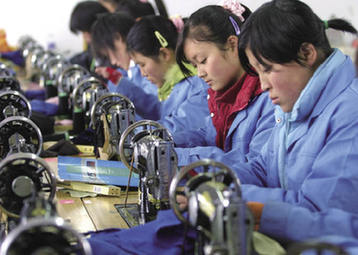|
Many local governments started with a focus on improving farm workers' skills, but found the real challenge was to enroll enough trainees or access sufficient numbers of qualified teachers. Training for farm workers is inadequate for promoting a reserve of talent in the agricultural industry in any case, thinks Cai Fang, director of the Institute of Population and Labor Economics, Chinese Academy of Social Sciences. The government should couple training, he believes, with related long-term policies that promote the overall professionalism of young farmers.
"We train the talents for what you need" is the can-do attitude valued by Zhang Xiulan, dean of School of Social Development and Public Policy, Beijing Normal University. In his opinion, the government should run training sessions specifically geared to labor market deficits, supported by formal methods for enterprises to specify to governments or schools their detailed labor requirements. After a thorough on-site inspection of laid-off migrant workers, Dean Zhang also concluded that the solution to labor shortages should be based on the joint efforts of industry and institutions dedicated to vocational training. Concern for efficiency must be paramount for educational reform to be successful.
In fact, enterprises have always driven the content of vocational preparation, and been the main supporters of technical training. During the last quarter of the century, about 300 million people in China have qualified for positions under their companies' regular or special training activities. Private trade schools have also flourished in this kind of partnership. Their number now reaches 3000, against a total of 160,000 such institutions.
"The reform and development of vocational training is a breakthrough for the entire education system, especially the formal cooperation between companies and schools, and also for industry and education in general," according to Chen Yu, who is confident that "reform will allow education to more directly serve the goals of economic production and stability."
Funding the Needs: Flowers and Charcoal
|
 |
|
Women learn sewing in a trainig session held in Hai'an County, Jiangsu. |
In a further comparison of academic versus vocational paths, the record shows that from 2004 to 2008, the average employment rate of postgraduate students declined by two percent. Even for college graduates, it declined by one percent. But vocational school graduates enjoyed a two percent increase.
Of 70 million industrial workers, skilled workers just account for one third, of which 40 percent are classified as seniors, 60 percent juniors.
It is hard to imagine how the private sector in a country of 1.3 billion can manage its adjustment to labor market realities without the benefit of governmental coordination. "In China, the responsibility to improve vocational training is the government's," asserts Jiang Dayuan, adding that private schools are only a supplementary force for the massive maneuvering needed. Adequate funding of a national implementation of related policies is also the administration's headache. The budget for education has been around 3 percent of GDP in the last decade, much lower than the world average of 7, and even lower than the developing countries of 4.1. The earmark for vocational training has hovered around a mere 6 to 7 percent of the total educational budget.
The difficulty is determining the share of funds needed and deserved by various bodies. Funding has always been a bottleneck, acknowledges Chen Zupei, vice-president of Beijing Fu-ping School, whose institution is heavily dependent on private donations made by famous scholars like Mao Yushi and Tang Min. Teachers there have a salary between RMB 1,000 and 1,500 every month, much lower than Beijing's average monthly salary of RMB 3,700 in 2008. Researcher Jiang Dayuan uses a vivid metaphor to express his views on fairness: "Increasing the input to higher education is like adding flowers to brocade, while to trade schools we send coal in snowy weather."
In his government work report released last March, Premier Wen Jiabao promised the government "will attach greater importance to vocational training, especially secondary school trade instruction in the countryside, including a policy of free tuition." Meanwhile MOE will raise its enrollment in vocational schools by 500,000 to reach 8.6 million. Expert consensus is that in this economic downturn, workers will benefit from more and better skills, and vocational education be renewed by the call for far-reaching reforms.
The authors are staff reporters of Financial Digest.
|
